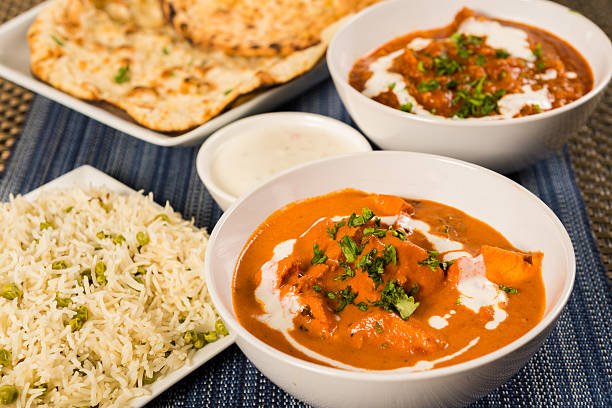Indian food

Indian food is one of the world's most diverse and flavorful cuisines, celebrated for its rich history, vibrant spices, and deep cultural roots. The cuisine varies significantly across the vast country, shaped by regional diversity, religious influences, and centuries of culinary traditions. Here’s an exploration of Indian food, highlighting its regional differences, popular dishes, and unique cooking techniques.
Key Ingredients and Spices
Indian cuisine is renowned for its use of spices and herbs, which form the backbone of its distinctive flavors. Commonly used spices include:
Turmeric: Adds a golden color and earthy flavor, with anti-inflammatory properties.
Cumin: Often used whole or ground, it provides a warm, nutty taste.
Coriander: Fresh leaves and dried seeds are used for a citrusy note.
Ginger and Garlic: Essential for creating the base of many Indian dishes, lending heat and pungency.
Garam Masala: A blend of ground spices like cinnamon, cloves, cardamom, and black pepper that adds complexity.
Chilies: Both fresh and dried varieties add heat and spice.
These spices are typically roasted to enhance their flavors before being used in dishes, which is a defining characteristic of Indian cooking.
Regional Variations
India's cuisine is incredibly diverse, reflecting the country's geography, climate, and cultural influences. Here are some highlights from various regions:
- North India (Punjabi, Mughlai, and Rajasthani Cuisine)
Staples: Wheat-based flatbreads like naan, roti, and paratha are common.
Dishes: Popular dishes include Butter Chicken (Murgh Makhani), Rogan Josh, Palak Paneer, and Biryani.
Flavors: Rich, creamy curries with a focus on dairy, such as ghee (clarified butter) and yogurt, are common.
Street Food: The region is famous for snacks like Chole Bhature, Samosas, and Aloo Tikki.
- South India (Andhra, Tamil Nadu, Kerala, and Karnataka Cuisine)
Staples: Rice is the main staple, often served with lentil-based dishes like Sambar and Rasam.
Dishes: Signature dishes include Dosas, Idlis, Vada, Chettinad Chicken, and Fish Curry.
Flavors: The cuisine uses coconut, curry leaves, tamarind, and mustard seeds extensively, with an emphasis on tangy and spicy flavors.
Street Food: Popular snacks include Masala Dosa, Paniyaram, and Banana Chips.
- Western India (Maharashtrian, Gujarati, and Goan Cuisine)
Staples: The region has a mix of rice, millet, and wheat-based dishes.
Dishes: Notable dishes include Pav Bhaji, Vada Pav, Goan Fish Curry, and Puran Poli.
Flavors: The cuisine of Goa incorporates Portuguese influences, with seafood, coconut milk, and vinegar playing a central role. Gujarati cuisine is mostly vegetarian, focusing on a balance of sweet, sour, and spicy flavors.
Street Food: Famous snacks include Dhokla, Khandvi, and Bombay Sandwich.
- Eastern India (Bengali, Odia, and Assamese Cuisine)
Staples: Rice and fish are the cornerstones of Bengali and Assamese diets.
Dishes: Popular dishes include Fish Curry (Maacher Jhol), Prawn Malai Curry, and sweets like Rasgulla and Sandesh.
Flavors: Mustard oil, panch phoron (a blend of five spices), and fresh green chilies are used extensively.
Street Food: Delicacies like Puchka (Pani Puri) and Jhalmuri are widely enjoyed.
Popular Indian Dishes
Here’s a look at some of the iconic dishes that have gained global recognition:
- Biryani: A fragrant rice dish cooked with aromatic spices, meat (often chicken or mutton), and occasionally vegetables. Each region has its unique take, like the spicy Hyderabadi biryani or the milder Lucknowi biryani.
- Butter Chicken: A rich, creamy tomato-based curry made with tender chunks of chicken. It is a favorite in Indian restaurants worldwide.
- Samosa: Deep-fried pastry filled with spiced potatoes, peas, or meat. It's a popular snack or appetizer.
- Dosa: A thin, crispy crepe made from fermented rice and lentil batter, often filled with a spicy potato mixture and served with coconut chutney and sambar.
- Paneer Tikka: Marinated paneer (Indian cottage cheese) cubes grilled to perfection, often served with mint chutney.
- Chole Bhature: A hearty combination of spicy chickpea curry and fluffy deep-fried bread.
Indian Desserts
India has a rich tradition of sweets (known as mithai), often associated with festivals, celebrations, and religious rituals:
Gulab Jamun: Deep-fried milk dough balls soaked in sugar syrup flavored with rose water or cardamom.
Jalebi: Deep-fried spirals made from fermented batter, soaked in sugar syrup.
Kheer: A creamy rice pudding made with milk, sugar, and flavored with cardamom, saffron, and nuts.
Ladoo: Sweet balls made from flour, sugar, and ghee, with variations like Besan Ladoo (chickpea flour) and Motichoor Ladoo.
Vegetarianism and Religious Influences
India has one of the highest populations of vegetarians in the world, largely due to religious beliefs, particularly in Hinduism, Jainism, and Buddhism. As a result, Indian cuisine features an impressive array of vegetarian dishes, making it one of the most diverse and satisfying plant-based cuisines globally.
Cooking Techniques
Indian cooking involves a range of techniques to extract and combine flavors:
Tadka/Tempering: Heating spices in hot oil or ghee to release their essential oils before adding them to a dish.
Dum Cooking: A slow-cooking technique where ingredients are sealed and cooked over low heat to retain flavors, commonly used for biryani.
Tandoori Cooking: Grilling marinated meats or breads in a tandoor, a traditional clay oven, to achieve smoky flavors.
Health Benefits of Indian Cuisine
Traditional Indian food emphasizes fresh, whole ingredients, and is rich in vegetables, grains, and legumes. The use of spices like turmeric, cumin, and ginger is known to have anti-inflammatory, digestive, and antioxidant properties. Many dishes are naturally gluten-free, vegetarian, and even vegan.
Conclusion
Indian food is more than just sustenance; it’s a way of life, steeped in history and culture. Each dish tells a story of the region, community, and traditions from which it originates. The complexity of flavors, the balance of spices, and the sheer diversity of dishes ensure that Indian cuisine has something for everyone, whether you’re craving something spicy, tangy, sweet, or savory.